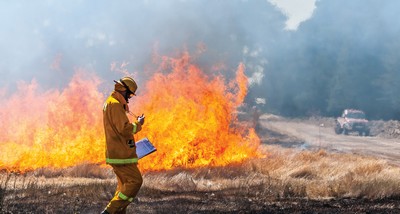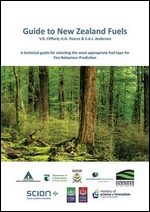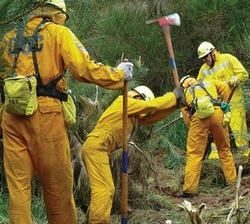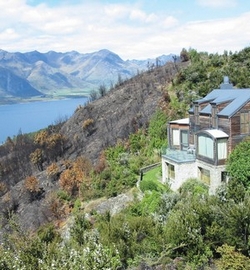Building community awareness of fire risks

Scion’s Rural Fire Research Team has been running hot this past year with the fire research programme again receiving Gold status in the Ministry of Business, Innovation and Employment’s (MBIE) annual reporting round, one of only 18 awards over 250 contracts.
This is a huge achievement for the team. The success is due in part to the development of new technologies, particularly fire behaviour tools such as smart phone ‘apps’, and a range of tools and recommendations for end-users based on sound science. It’s also reflective of the extensive collaboration undertaken by team members with researchers, industry groups and communities, both nationally and internationally.
Photo guide makes it easier to identify fuel type
Over the years Scion has developed a range of fire behaviour models and prediction tools to help fire managers calculate how fast a fire is likely to spread and how best to control it. In the heat of the moment, choosing the wrong fuel type could prove a costly decision. Scion’s recently published Guide to New Zealand Fuels contains 110 pages of images and technical descriptions of the different fire fuel types in New Zealand, making it easier for fire managers to choose the most appropriate behaviour model to use in prediction tools such as the Fire Behaviour Field Manual or smart apps.
Scion’s recently published Guide to New Zealand Fuels contains 110 pages of images and technical descriptions of the different fire fuel types in New Zealand, making it easier for fire managers to choose the most appropriate behaviour model to use in prediction tools such as the Fire Behaviour Field Manual or smart apps.
“There are currently 18 individual fuel types recognised in New Zealand, with 18 fuel load and nine rate-of-spread models available to predict fire behaviour,” explains fire researcher Veronica Clifford. “Selecting the proper fuel model that represents the fuel types present is one of the most important decisions to make when choosing which fire prediction model to use. For example, a fire in a forest or sparse scrubland with a grass understory may be supported entirely by the grass rather than the trees themselves and their behaviours are very different.
“Fire managers have to assess the physical characteristics of the fuels present too – like quantity, moisture content, condition and arrangement. Environmental aspects and site conditions also play a major role in fire behaviour.”
For added versatility, a condensed version of the photo guide for field use is available along with an electronic version that has been added to Scion’s Fire Behaviour Toolkit calculator software. The photo guide and prediction tools are already being widely used by fire managers.
Mapping the high-risk zones
At a more strategic level, the research team has developed a way of mapping the risk of wildfire in rural-urban areas. Areas that are particularly vulnerable are where flammable vegetation borders people and property, jeopardising people’s lives should fire break out. The methodology will have enormous benefits for rural fire managers.
“Knowing areas that have a high fire risk means fire authorities can prioritise their activities – like fire prevention measures, or creating fire breaks, reducing vegetation and promoting FireSmart communities,” says fire researcher Grant Pearce. “Councils and fire agencies can also use this information to strengthen planning and building regulations in high fire risk zones.”
This information will be collated with similar studies on other natural hazards as part of Scion’s work with the ‘Resilience to Nature’s Challenges’ science challenge to help communities build resilience to the forces of nature.
 Keeping our firefighters fit and well
Keeping our firefighters fit and well
Following a thorough review of the National Rural Fire Authority (NRFA) health and fitness guidelines for volunteer firefighters, our Fire Research Team has proposed a new ‘fit for purpose’ approach to fitness standards.
Fighting forest and rural fires is physically demanding and a high level of fitness is required to minimise fatigue and to work competently and safely. The study provides recommendations for minimum fitness standards for different firefighting tasks, based on discussion with firefighters and fire agencies, and a review of international approaches.
Building community resilience to wildfires
Around 3,000 wildfires occurred each year between 1992 and 2007, and research suggests that many rural communities are unaware of the risk of causing rural fires and ill prepared to protect themselves should one occur.
“Communicating with communities in wildfire areas is not a simple one size fits all approach,” says social scientist Lisa Langer, who has recently completed a study aimed at increasing community awareness, careful use of fire and preparedness for wildfire. “Communication needs to be targeted, with messages tailored to suit the audience. Fire users and non-users within rural communities need different messages, and various methods of communication are appropriate in particular situations. For example, rural or semi-rural fire users need to be kept aware of fire risks, restrictions (such as permits and fire seasons), and prevention and preparedness should a wildfire occur.
“Similarly, recreational fire users, such as those lighting campfires and fireworks, need tailored communications on awareness, fire restrictions and fire prevention, whereas non-users just need messages on awareness and how to be prepared for wildfires to ensure everyone in the community is safe.”
 The ‘Effective Communication’ study is part of a wider Australasian Bushfire CRC programme, ‘Communicating Risk’, led by RMIT University in Melbourne and Lisa hopes to combine her research with studies undertaken in Australia. She is currently providing rural fire communication recommendations for New Zealand agencies based on her findings.
The ‘Effective Communication’ study is part of a wider Australasian Bushfire CRC programme, ‘Communicating Risk’, led by RMIT University in Melbourne and Lisa hopes to combine her research with studies undertaken in Australia. She is currently providing rural fire communication recommendations for New Zealand agencies based on her findings.
Lisa has also been working with the Technical University of Lisbon to adapt the study for use with rural Portuguese communities and provide a wider international perspective. Information gathered as part of all these studies will be used to explore the nature of community networks and help communities be better prepared for natural disasters in the future.
For further information:
Contact Dr Richard Parker at Show email
